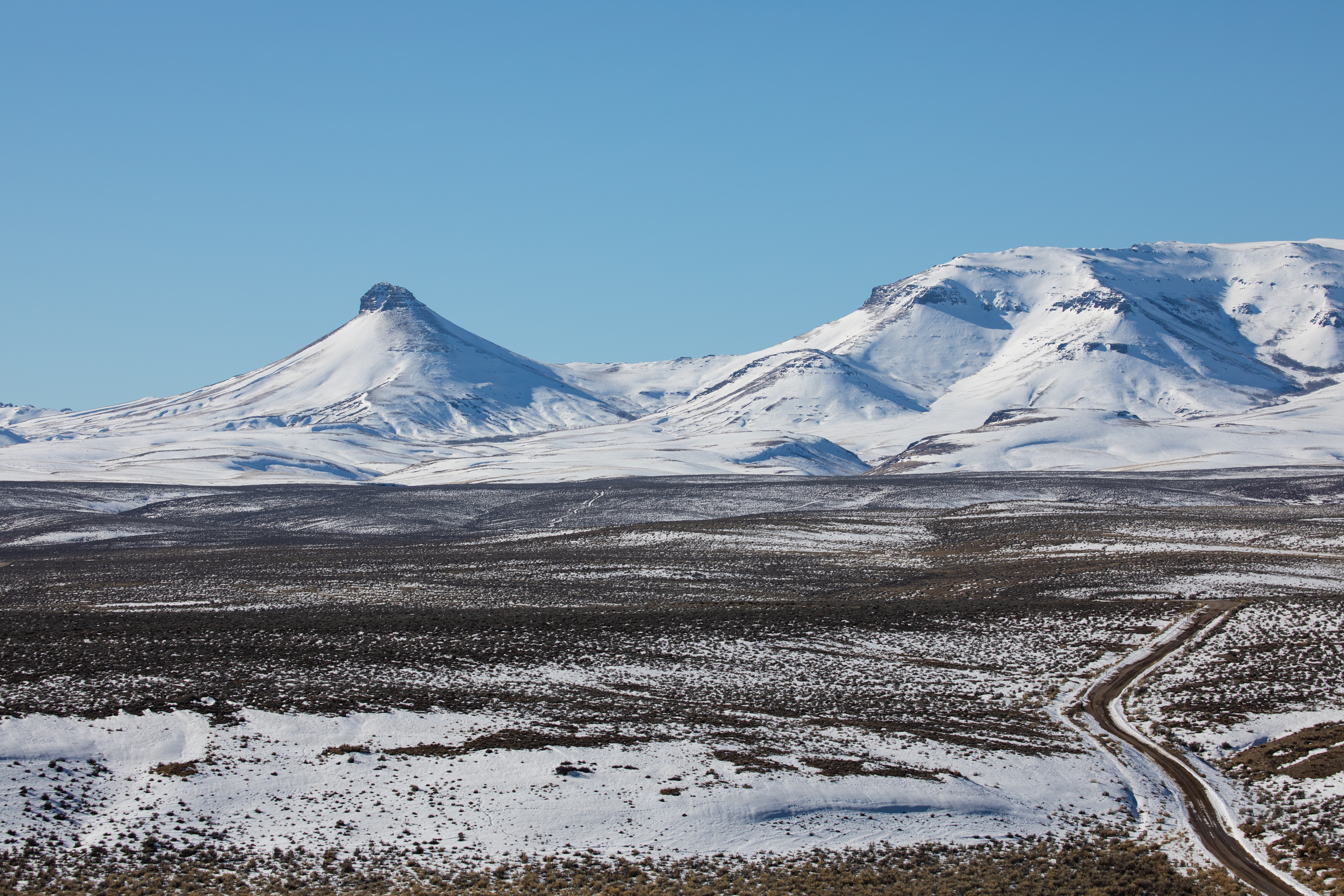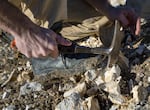
Disaster Peak, left, punctuates the northwest rim of the McDermitt Caldera in southeast Oregon, Jan. 14, 2022. The historic lakebed in the foreground contains some of the highest concentrations of lithium in the United States.
Bradley W. Parks / OPB
Sammy Castonguay broke a chunk of rock off a small outcropping on the northeast rim of the McDermitt Caldera on the Oregon-Nevada border and pinned it to the ground with his boot. He raised his hammer and, with a gentle swing, smashed the rock into smaller pieces.
Castonguay was collecting samples for his geology students at Treasure Valley Community College in Ontario, Oregon, on a sunny Friday in January. He said teaching about this ancient supervolcano is a lot easier when he can hand a piece of the soft, white rock to his pupils.
“Last time I was out here, I think I only gathered like five samples,” Castonguay said, admiring a specimen striped with burnt orange. “And those walked away really quickly.”

Sammy Castonguay breaks rocks from the McDermitt Caldera into samples for his geology students.
Bradley W. Parks / OPB
Others are looking for their piece of the McDermitt Caldera too.
The caldera has some of the highest concentrations of lithium in the United States. Lithium is the lightest metal on earth and highly reactive, making it an ideal ingredient in batteries to power cellphones, laptops and electric vehicles.
The British Columbia-based company Lithium Americas is moving forward with a mining project on the southern tip of the caldera in Nevada that has drawn lawsuits and protests.
Meanwhile, Australia-based Jindalee Resources is exploring a lithium deposit on the Oregon side of the caldera that it says could be the biggest in the country. No mine has been proposed in Oregon, but after scoping the Bureau of Land Management site, Jindalee says the deposit could eventually support one.

A map of the McDermitt Caldera on the Oregon-Nevada border.
MacGregor Campbell / OPB
The “lithium rush” is coming to the Beaver State as the U.S. and global powers seek more of the metal to power electric vehicles and store renewable energy from wind and solar. Digging up Oregon’s lithium would mean sacrificing this chunk of the sagebrush sea to provide the nation with a key ingredient to wean itself off fossil fuels.
Castonguay says it’s important to know the history of the McDermitt Caldera and how it formed before deciding whether to alter this landscape forever.
“This feature we’re talking about and waving our arms around is 16 million years old,” Castonguay said, gesturing to the vast caldera before him. “And we’re about to make decisions in five, 10 years about this thing. That’s a blink of an eye in geologic time.”
An eruption to dwarf St. Helens
Castonguay scribbled field notes as the sun melted the thin layer of snow cover and turned the ground to soup. He said this was not the place to be 16.4 million years ago.
“We would not want to be standing here,” Castonguay said. “This is the site of an immense eruption.”

Sammy Castonguay writes field notes on a trip to the McDermitt Caldera. “This feature we’re talking about and waving our arms around is 16 million years old,” Castonguay said. “And we’re about to make decisions in five, 10 years about this thing. That’s a blink of an eye in geologic time.”
Bradley W. Parks / OPB
The same hotspot that causes volcanic activity at Yellowstone National Park today was heating up McDermitt at the time. Contrary to other volcanoes, which are created by colliding or diverging tectonic plates, hotspots are relatively stationary and are the result of hot material near the center of the earth rising to the surface.
The hotspot warmed a magma chamber, creating pressure that caused the volcano to erupt.
Chris Henry, a research geologist emeritus at the University of Nevada-Reno and the Nevada Bureau of Mines and Geology who helped make the first geologic map of the McDermitt Caldera, said the eruption was unlike anything anyone alive today has ever seen.
“What happens in this is the magma’s bubbling up, and it shoots up in a big column,” Henry said. “That column collapses, and it flows out as very hot, fairly dense, gas-rich, magma particle-rich flows. They’re very hot. They cook everything.”
The McDermitt eruption ejected about 1,000 times more magma than Mount St. Helens in 1980, blazing a trail of destruction.
“Any wildlife, any vegetation in the immediate area would really be destroyed, sadly,” Henry said. “Mount St. Helens killed a bunch of people, knocked down a lot of forest; this was a much bigger eruption, and it would have done even more so.”
Lost lake
The hollowed-out magma chamber was no longer strong enough to hold the land above, so the center of the volcano collapsed into the void, creating a lakebed surrounded by mountains and buttes.

Sammy Castonguay draws a diagram of the Jindalee lithium claim in Oregon. McDermitt's most economically viable lithium is stored in lakebed clays.
Bradley W. Parks / OPB
Today, the McDermitt Caldera blends into the tan satellite view of the arid American West. But up until at least 15.7 million years ago, Henry said, the caldera was filled with water like Crater Lake and Newberry Crater to the west.
Over time, the lake that filled McDermitt Caldera slowly eroded the rhyolite rim that held the water in place. That erosive process is what moved a lot of the lithium stored in the rim of the caldera into the lakebed clays, but Henry said an additional source of lithium is likely.
The unique geology of the McDermitt Caldera, coupled with a fortuitous drawing of state lines, has positioned Oregon and its poorest county, Malheur, to play a major role in the global transition to renewable energy.
“I think that Oregonians need to know about this specific geology and this specific mineral that’s here in lithium because it plays such an immense role in the future of climate change,” Castonguay said.

Sammy Castonguay nibbles a rock to measure its grain size.
Bradley W. Parks / OPB
Smaller eruptions continued in and around the McDermitt Caldera for a few hundred thousand years after the initial blast 16.4 million years ago. Volcanic activity died down at McDermitt as the North American tectonic plate slowly moved over the hotspot (imagine a sheet of cookies baking over a Bunsen burner), leaving a trail of volcanic centers from here to Yellowstone.
None of them seems to have the type of lithium deposits found at McDermitt. Scientists aren’t sure why.
“And that’s real curious because it would seem like the same geology and the same geologic processes occurred in these other places, so why don’t they have lithium?” Henry said. “And that’s a real big question and one we’re puzzling over.”
Oregon’s opportunity
The American appetite for lithium is more voracious than it’s ever been.
Most people have a lithium-ion battery in their pocket and many of them replace it every few years. Carmakers like General Motors have made promises to go at least partially if not fully electric within the next few years.
“These are things that directly affect people’s lives,” Henry said. “If we want to have electric vehicles and a lot of other electrical applications, we’re gonna need to have the materials that go into those batteries, and currently lithium is the really big thing.”

A drill rig is parked on the northeast rim of the caldera.
Bradley W. Parks / OPB
While U.S. lithium consumption has spiked, production hasn’t.
The only lithium produced in the United States last year came from a brine extraction facility near Silver Peak, Nevada — a project that’s been online since the 1960s. The U.S. imports the majority of its lithium products from Argentina, Chile, China and Russia.
The Trump administration labeled lithium a critical mineral in 2018, expediting the approval process for lithium mining and exploration. The Biden administration has since announced its intent to source, refine and recycle more lithium domestically.
Some are excited by the prospect of lithium extraction in Oregon. Greg Smith, who directs Malheur County’s economic development agency, says a mine could provide well-paying jobs and spur growth in other sectors like housing and hospitality. Malheur County has the highest poverty rate in the state, according to a 2020 report from the Oregon Center for Public Policy.
Smith said he’s also aware of the controversy created by a proposed lithium mine on the Nevada side of the McDermitt Caldera at Thacker Pass. That project has attracted multiple lawsuits, including from the nearby Fort McDermitt Paiute and Shoshone and Burns Paiute tribes.
“For us to be able to create this economic opportunity, we’re gonna have to do it the Oregon way,” Smith said. “And we’re gonna have to make sure that it’s done in a manner that benefits all parties.”

Piles of waste from abandoned mercury mines in the McDermitt Caldera.
Bradley W. Parks / OPB
Mineral exploration and geologic study have proven the state has a lot of lithium. It’s unclear whether Oregonians will support digging it all up.
You can still see the remnants from the last time Oregon mined the McDermitt Caldera. Castonguay pointed to cinnamon- and ginger-colored piles of waste left over from uranium and mercury extraction years ago.
“It is a gift to have the conversation about this metal,” Castonguay said of lithium. “And to make short-lived, quick decisions, we are so far beyond that. We’ve paid that price before.”
